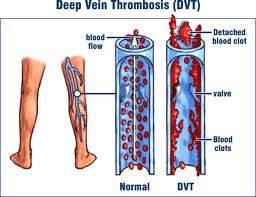A new study from Australia has shown that the risk for developing blood clots in the legs (deep vein thrombosis) is increased 4-fold in the first two weeks after a long-haul airplane flight. This was published on Nov. 8, 2003 in the British Medical Journal (BMJ. 2003;327:1072) with the lead author being Dr. C.W. Kelman of the Commonwealth Department of Health and Ageing, Canberra.
Data was collected of 5,408 patients who had been hospitalized to Western Australian hospitals for deep vein thrombosis between 1981 and 1999. A total of 153 Australians were admitted with blood clots in the leg veins within 100 days of international flights. 46 of these patients developed their blood clots within 14 days of arrival, which was much more than would have been expected in the general population. The researchers found that between 15 days and 100 days following a long-haul flight the risk of developing clots in the deep veins of the legs was not increased from the background rate of the general population. The patients who had developed their blood clots within 14 days of a long flight had a risk that was 4.17-fold higher than the average population’s risk. Of these patients 76% were thought to have developed the clots as a result of a flight. In terms of a yearly risk, if a person does one long-haul flight per year, the probability of developing a clot in the leg veins would be about 12% higher than in a non-traveling comparison group. As this condition is treated effectively with blood thinners, the death rate is quite low, approximately 1 per 2 million long-haul flights.
This would be much lower than the risk of death from car accidents. The authors suggested that more study is needed to determine the risk factors for developing flight induced deep vein thrombosis. When this is known, investigations will be able to concentrate on blood clot prevention from air travel.
Link to a chapter on pulmonary emboli, which can develop from a deep vein thrombus that breaks loose.
Last edited December 9, 2012






